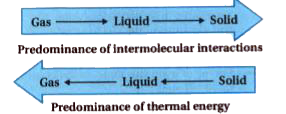Intermolecular forces and thermal energy decide physical state of matter. Explain Solution in Gujrati
Intermolecular forces tend to keep the molecules together but thermal energy of the molecules tends to keept them apart. Three states of matter are the result of balance between intermolecular forces and the thermal energy of the molecules.
When molecular interactions are very weak, molecules do not cling together to make liquid or solid unless thermal energy is reduced by lowering the temperature.
Gases do not liquify on compression only, although molecules come very close to each other and intermolecular forces operate to the maximum.
However, when thermal energy of molecules is reduced by lowering the temperature, the gases can be very easily liquified.
Predominance of thermal energy and the molecular interaction energy of a substance in three states is depicted as follows :

So, we know that all the three states of matter solid, liquid and gas how situated.
..When temperature of gas decreases and decreases thermal energy liquifaction of gas occurs but we can.t obtained state liquid or solid after compressibility of gas we should decrease thermal energy...
Topper's Solved these Questions
- STATES OF MATTER BOOK - KUMAR PRAKASHANCHAPTER - STATES OF MATTER EXERCISE - SECTION - A QUESTIONS (Sub Question)
3 Videos
- STATES OF MATTER BOOK - KUMAR PRAKASHANCHAPTER - STATES OF MATTER EXERCISE - SECTION - A QUESTIONS (TRY YOUR SELF)
47 Videos
- SOME BASIC CONCEPTS OF CHEMISTRYBOOK - KUMAR PRAKASHANCHAPTER - SOME BASIC CONCEPTS OF CHEMISTRYEXERCISE - Section - D (Solutions of NCERT Exemplar Problems) (Long Answer Type Questions)
4 Videos
- STRUCTURE OF ATOMBOOK - KUMAR PRAKASHANCHAPTER - STRUCTURE OF ATOMEXERCISE - QUESTINS PAPER FROM MODULE (SECTION -D)
2 Videos
Similar Questions
Derive Boyle.s formula according to his law.
View SolutionAt 300 K constant temperature gas having 20cm3, 1 bar pressure it is convert into 50cm3 then calculated pressure ?
View SolutionA vessel contains 1.6 g of dioxygen at STP (273.15 K, 1 atm pressure). The gas is now transferred to another vessel at constant temperature, where pressure becomes half of the original pressure. Calculate
(A) volume of the new vessel.
(B) number of molecules of dioxygen.
View SolutionExplain Heisenberg’s uncertainty principle.
View SolutionAssertion (A) Three states of matter are the result of balance between intermolecular forces and thermal energy of the molecules. Reason (R) Intermolecular forces tend to keep the molecules together but thermal energy of molecules tends to keep tham apart.
View SolutionIn which state of matter (a) Intermolecular forces are the maximum. (b) Diffusion is the least (c ) Intermolecular spaces are the maximum ?
View SolutionAssertion (A) Three states of matter are the result of balance between intermolecular forces and thermal energy of the molecules.
Reason (R) Intermolecular forces tend to keep the molecules together but thermal energy of molecules tends to keep tham apart.
View SolutionAssertion:At low temperature , particles of matter occupy fixed positions and exist in solid state.
Reason : Under a given set of conditions of temperature and pressure , the state of a substance depends upon the net effect of thermal energy and intermolecular forces.
View SolutionIf thermal energy predominates over intermolecular forces, then the substance changes from……..to……..
View SolutionWhich state of matter has least intermolecular forces of attraction?
View SolutionIf thermal energy predominates over intermolecular forces, then the substance changes from __to__
View SolutionAssertion (A) Three states of matter are the result of balance between intermolecular forces and thermal energy of the molecules. Reason (R) Intermolecular forces tend to keep the molecules together but thermal energy of molecules tends to keep tham apart.
View SolutionAssertion (A) : Three states of matter are the result of balance between intermolecular forces and thermal energy of the molecules.
Reason (R ) : Intermolecular forces tend to keep the molecules together but thermal energy of molecules tends to keep them apart.
View SolutionWrite a critical account of intermolecular forces versus thermal energy ?
View SolutionIn which state of matter is the intermolecular force a. the maximum b. the minimum?
View Solution
